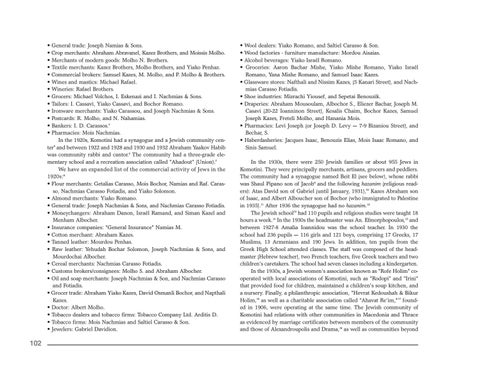• General trade: Joseph Namias & Sons. • Crop merchants: Abraham Abravanel, Kazez Brothers, and Moissis Molho. • Merchants of modern goods: Molho N. Brothers. • Textile merchants: Kazez Brothers, Molho Brothers, and Yiako Penhaz. • Commercial brokers: Samuel Kazes, M. Molho, and P. Molho & Brothers. • Wines and mastics: Michael Rafael. • Wineries: Rafael Brothers. • Grocers: Michael Volchos, I. Eskenazi and I. Nachmias & Sons. • Tailors: I. Cassavi, Yiako Cassavi, and Bochor Romano. • Ironware merchants: Yiako Carassou, and Joseph Nachmias & Sons. • Postcards: R. Molho, and N. Nahamias. • Bankers: I. D. Carassos.4 • Pharmacies: Mois Nachmias. In the 1920s, Komotini had a synagogue and a Jewish community center5 and between 1922 and 1928 and 1930 and 1932 Abraham Yaakov Habib was community rabbi and cantor.6 The community had a three-grade elementary school and a recreation association called "Ahadout" (Union).7 We have an expanded list of the commercial activity of Jews in the 1920s:8 • Flour merchants: Getalias Carasso, Mois Bochor, Namias and Raf. Carasso, Nachmias Carasso Fotiadis, and Yiako Solomon. • Almond merchants: Yiako Romano. • General trade: Joseph Nachmias & Sons, and Nachmias Carasso Fotiadis. • Moneychangers: Abraham Danon, Israél Ramand, and Siman Kazel and Menham Albocher. • Insurance companies: "General Insurance" Namias M. • Cotton merchant: Abraham Kazes. • Tanned leather: Mourdou Penhas. • Raw leather: Yehudah Bochar Solomon, Joseph Nachmias & Sons, and Mourdochai Albocher. • Cereal merchants: Nachmias Carasso Fotiadis. • Customs brokers/consignees: Molho S. and Abraham Albocher. • Oil and soap merchants: Joseph Nachmias & Son, and Nachmias Carasso and Fotiadis. • Grocer trade: Abraham Yiako Kazes, David Osmanli Bochor, and Napthali Kazes. • Doctor: Albert Molho. • Tobacco dealers and tobacco firms: Tobacco Company Ltd. Arditis D. • Tobacco firms: Mois Nachmias and Saltiel Carasso & Son. • Jewelers: Gabriel Davidion.
102
• Wool dealers: Yiako Romano, and Saltiel Carasso & Son. • Wood factories - furniture manufacture: Mordou Aisaias. • Alcohol beverages: Yiako Israél Romano. • Groceries: Aaron Bachar Mishe, Yiako Mishe Romano, Yiako Israél Romano, Yana Mishe Romano, and Samuel Isaac Kazes. • Glassware stores: Nafthali and Nissim Kazes, (5 Kanari Street), and Nachmias Carasso Fotiadis. • Shoe industries: Mizrachi Yiousef, and Sepetai Benouzik. • Draperies: Abraham Mousoulam, Albochor S., Eliezer Bachar, Joseph M. Casavi (20-22 Ioanninon Street), Kesalis Chaim, Bochor Kazes, Samuel Joseph Kazes, Freteli Molho, and Hanania Mois. • Pharmacies: Levi Joseph (or Joseph D. Levy — 7-9 Bizaniou Street), and Bechar, S. • Haberdasheries: Jacques Isaac, Benouzis Elias, Mois Isaac Romano, and Sinis Samuel. In the 1930s, there were 250 Jewish families or about 955 Jews in Komotini. They were principally merchants, artisans, grocers and peddlers. The community had a synagogue named Beit El (see below), whose rabbi was Shaul Pipano son of Jacob9 and the following hazanim (religious readers): Atas David son of Gabriel (until January, 1931),10 Kazes Abraham son of Isaac, and Albert Alboucher son of Bochor (who immigrated to Palestine in 1935).11 After 1936 the synagogue had no hazanim.12 The Jewish school13 had 110 pupils and religious studies were taught 18 hours a week.14 In the 1930s the headmaster was An. Efmorphopoulos,15 and between 1927-8 Amalia Ioannidou was the school teacher. In 1930 the school had 236 pupils — 116 girls and 121 boys, comprising 17 Greeks, 17 Muslims, 13 Armenians and 190 Jews. In addition, ten pupils from the Greek High School attended classes. The staff was composed of the headmaster (Hebrew teacher), two French teachers, five Greek teachers and two children's caretakers. The school had seven classes including a kindergarten. In the 1930s, a Jewish women’s association known as "Rofe Holim" cooperated with local associations of Komotini, such as "Rodopi" and "Irini" that provided food for children, maintained a children's soup kitchen, and a nursery. Finally, a philanthropic association, "Hevrat Kedoushah & Bikur Holim,16 as well as a charitable association called "Ahavat Re’im,"17 founded in 1906, were operating at the same time. The Jewish community of Komotini had relations with other communities in Macedonia and Thrace as evidenced by marriage certificates between members of the community and those of Alexandroupolis and Drama,18 as well as communities beyond
